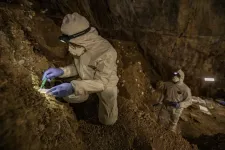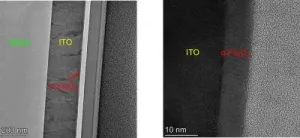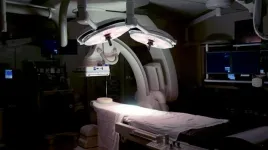(Press-News.org) Scientists have sequenced ancient DNA from soil for the first time and the advance will transform what is known about everything from evolution to climate change.
The findings have been described as the 'moon landings' of genomics because researchers will no longer have to rely on finding and testing fossils to determine genetic ancestry, links and discoveries - and it is thanks to Stone Age black bears who defecated in a remote cave in Mexico 16,000 years ago.
A team of scientists from The Lundbeck Foundation GeoGenetics Centre, University of Copenhagen, led by Professor Eske Willerslev, director of the foundation and a Fellow of St John's College, University of Cambridge, recreated the genomes of animals, plants and bacteria of microscopic fragments of DNA found in Chiquihuite Cave.
The results, which have been published today (April 19 2021) in Current Biology, are the first time environmental DNA has been sequenced from soil and sediment and includes the ancient DNA profile of a Stone Age American black bear taken from samples in the cave.
This 'scientific first' has wider significance as it increases scientists' ability to study the evolution of animals, plants and microorganisms, which has been hailed as the dawn of an 'entirely new era' of population genetics. The work was possible as a result of advanced technology and understanding over the past five years.
This is because working with highly fragmented DNA from soil samples means scientists no longer have to rely on DNA samples from bone or teeth for enough genetic material to recreate a profile of ancient DNA, which opens up the field to what can be tested and studied.
The samples included faeces and droplets of urine from an ancestor of North America's most familiar and common bear - the American black bear - which allowed scientists to recreate the entire genetic code of two species of the animal. The first is the Stone Age American black bear, the second is an extinct short-faced bear called Arctodus simus which died out 12,000 years ago.
Professor Willerslev said: "When an animal or a human urinates or defecates, cells from the organism are also excreted. And the DNA fragments from these cells are what we can detect in the soil samples. Using extremely powerful sequencing techniques, we reconstructed genomes - genetic profiles - based on these fragments for the first time. We have shown that hair, urine and faeces all provide genetic material which, in the right conditions, can survive for much longer than 10,000 years.
"All over the world, everyone scientifically involved in the study of ancient DNA recognised the need to reconstruct genomes from fragments found in soil or sediment. Being able to do that for the first time means we have opened up a new frontier. Analysis of DNA found in soil could have the potential to expand the narrative about everything from the evolution of species to developments in climate change - this is the moon landing of genomics because fossils will no longer be needed."
Chiquihuite Cave, where the samples were taken from, is a high-altitude site, 2,750 metres above sea level. Nearly 2,000 stone tools and small tool fragments, known as flakes, were discovered.
The same group of scientists revealed last year that DNA analysis of the plant and animal remains from the sediment packed around the tools in the cave dates the tools and the human occupation of the site to 25,000-30,000 years ago - 15,000 years earlier than people were previously thought to have reached the Americas. Human DNA has not yet been found.
DNA of mice, black bears, rodents, bats, voles and kangaroo rats was found and the genome of the two species of bear has now been sequenced. The huge predatory short-faced bear, which also lived in North America, stood at nearly two metres just on all fours and could weigh up to 1,000 kilos.
Assistant Professor Mikkel Winther Pedersen, first author of the paper, said: "The short-faced bears that lived in northern Mexico were distinctly different from the population of black bears living in north-western Canada. This is an excellent example of the new knowledge that suddenly becomes available when you reconstruct genomes based on DNA fragments extracted from soil."
Professor Pedersen described the new sequencing as 'the dawn of an entirely new era' of population genomics.
He said: "Studies of ancient environmental DNA have been very limited until now. Fragmented DNA from a soil sample could only tell us whether a specific species lived in a certain locality at a certain time, but it gave us no concrete details about the individual in question.
"So, we couldn't compare this individual with present-day individuals of the same species. But we can now. We have published for the first time a DNA profile of an American black bear that lived in a mountain cave in northern Mexico in the Stone Age. I'm not exaggerating when I say that the potential to extract this type of information from a soil sample of a mere few grams will revolutionise our field."
Fragments in sediment will be able to be tested in many former Stone Age settlements around the world.
Professor Willerslev added: "Imagine the stories those traces could tell. It's a little insane - but also fascinating - to think that, back in the Stone Age, these bears urinated and defecated in the Chiquihuite Cave and left us the traces we're able to analyse today."
Paper and images: https://drive.google.com/drive/folders/1Vu6hmTsmo1nJLWYEc3KGA4VtC8Uz-YLD?usp=sharing
INFORMATION:
April 19, 2021 - An estimated 50 million people undergo surgery each year in the United States, and a significant proportion of them have undiagnosed or untreated sleep disorders (SD) or sleep-disordered breathing (SDB). Issues at the intersection of anesthesiology and sleep medicine are the focus of the Society of Anesthesia and Sleep Medicine (SASM) whose 10th anniversary is commemorated in the special theme May issue of Anesthesia & Analgesia.
The special issue looks back at a remarkable first decade of achievements in research and clinical practice by this young subspecialty society, while looking forward to further progress. A key ...
More blood thinners aren't automatically better, another study confirms.
A new publication in JAMA Internal Medicine focuses on the minimal pros and the concerning cons of combining a daily aspirin with a drug from the newer class of anticoagulants that include apixaban, dabigatran, edoxaban and rivaroxaban.
Patients were taking one of these direct oral anticoagulants known as DOACs to prevent strokes from non-valvular atrial fibrillation or for the treatment of venous thromboembolic disease (deep vein thrombosis or pulmonary embolism). The included patients did not have another reason to take aspirin ...
PHILADELPHIA - A new gene therapy for one of the most common forms of congenital blindness was safe and improved patients' vision, according to initial data from a clinical trial led by researchers at the Scheie Eye Institute in the Perelman School of Medicine at the University of Pennsylvania.
The therapy delivers working copies of GUCY2D to the eyes of patients who have severe vision impairments caused by mutations in the gene. Each of the first three treated patients experienced improvement in some aspects of vision, without serious side effects, according to the new study, published in the journal iScience.
"We found sustained improvements in both day and night vision, even with a relatively low dose of the gene therapy," said study lead author Samuel G. Jacobson, MD, ...
A new study outlines the need for materials advances in the hardware that goes into making quantum computers if these futuristic devices are to surpass the abilities of the computers we use today.
The study, published in the journal Science by an international team, surveyed the state of research on quantum computing hardware with the goal of illustrating the challenges and opportunities facing scientists and engineers.
While conventional computers encode "bits" of information as ones and zeroes, quantum computers breeze past this binary arrangement by creating "qubits," which can be complex, continuous quantities. Storing and manipulating information ...
JACKSONVILLE, Fla. -- In a new paper published in Nature Communications, Mayo Clinic researchers and collaborators report the protein-coding gene SERPINA5 may worsen tau protein tangles, which are characteristic of Alzheimer's disease, and advance disease. By combining clinical expertise, brain tissue samples, pathology expertise and artificial intelligence, the team clarified and validated the relevance of the gene to Alzheimer's disease.
The researchers used tissue samples from 385 brains donated to the Mayo Clinic Brain Bank, which houses more than 9,000 brain tissue specimens for the study of neurodegenerative disorders. The samples were from people who were diagnosed with Alzheimer's disease and lacked co-existing diseases found in ...
Hydrogen will be needed in large quantities as an energy carrier and raw material in the energy system of the future. To achieve this, however, hydrogen must be produced in a climate-neutral way, for example through so-called photoelectrolysis, by using sunlight to split water into hydrogen and oxygen. As photoelectrodes, semiconducting materials are needed that convert sunlight into electricity and remain stable in water. Metal oxides are among the best candidates for stable and inexpensive photoelectrodes. Some of these metal oxides also have catalytically active surfaces that accelerate the formation of hydrogen at the cathode or oxygen at the anode.
Why is rust not much better?
Research has long focused on haematite (α-Fe2O3), ...
MINNEAPOLIS - April 19, 2021 - Despite access to some of the best possible medical care in the world, Senators John McCain and Edward Kennedy both died within 18 months of their diagnosis of glioblastoma, an aggressive form of brain cancer. While this deadly outcome typifies the nature of this disease, some glioblastoma patients see exceptional benefits from chemotherapy and survive beyond expectations. Why this happens has been revealed by researchers at the University of Minnesota in a new study published in the Proceedings of the National Academy of Sciences.
"Deciphering the molecular underpinning of these exceptional ...
In March 2020, when the pandemic hit, everything slowed, including non-essential medical procedures such as elective surgeries, to reduce the spread of the coronavirus.
Six weeks later, Mary Byrnes, Ph.D., an assistant research scientist in the Department of Surgery at Michigan Medicine, began calling University of Michigan Frankel Cardiovascular Center patients whose surgeries had been canceled or delayed. She wanted to hear about their experiences -- what undergoing surgery meant to them, how postponing their operations had affected them, whether the existence of the coronavirus complicated how they felt about their bodies and ...
Psoriasis is a common inflammatory skin condition. The underlying genetic factors have not yet been sufficiently researched. The skin inflammation is usually triggered by external factors such as infections or stress. A research team at the Institute of Cancer Research of the Medical University of Vienna has now managed to identify a new factor in signal transmission of the immune system that plays a major role in the development of a psoriatic episode. The scientists have shown that symptoms can be alleviated by inhibiting the "c-Jun" protein in signal transmission.
The common clinical manifestation of psoriasis is a pinkish-grey thickening of the epidermis in distinct foci of infection, ...
It has been known for about a year that minks can become infected with SARS-CoV-2. The virus had been transmitted from humans to farmed mink and mutated in infected animals. Mutations were acquired in the spike protein, which is crucial for the entry of the virus into host cells and represents the central point of attack for antibodies. These SARS-CoV-2 variants from mink were transmitted back to humans, raising concerns that minks could be a continuing source of infection of humans with SARS-CoV-2 variants with altered biological properties. Researchers at the German Primate Center (DPZ) - Leibniz Institute for Primate Research in Göttingen, Germany, have now shown that an antibody used for COVID-19 ...



